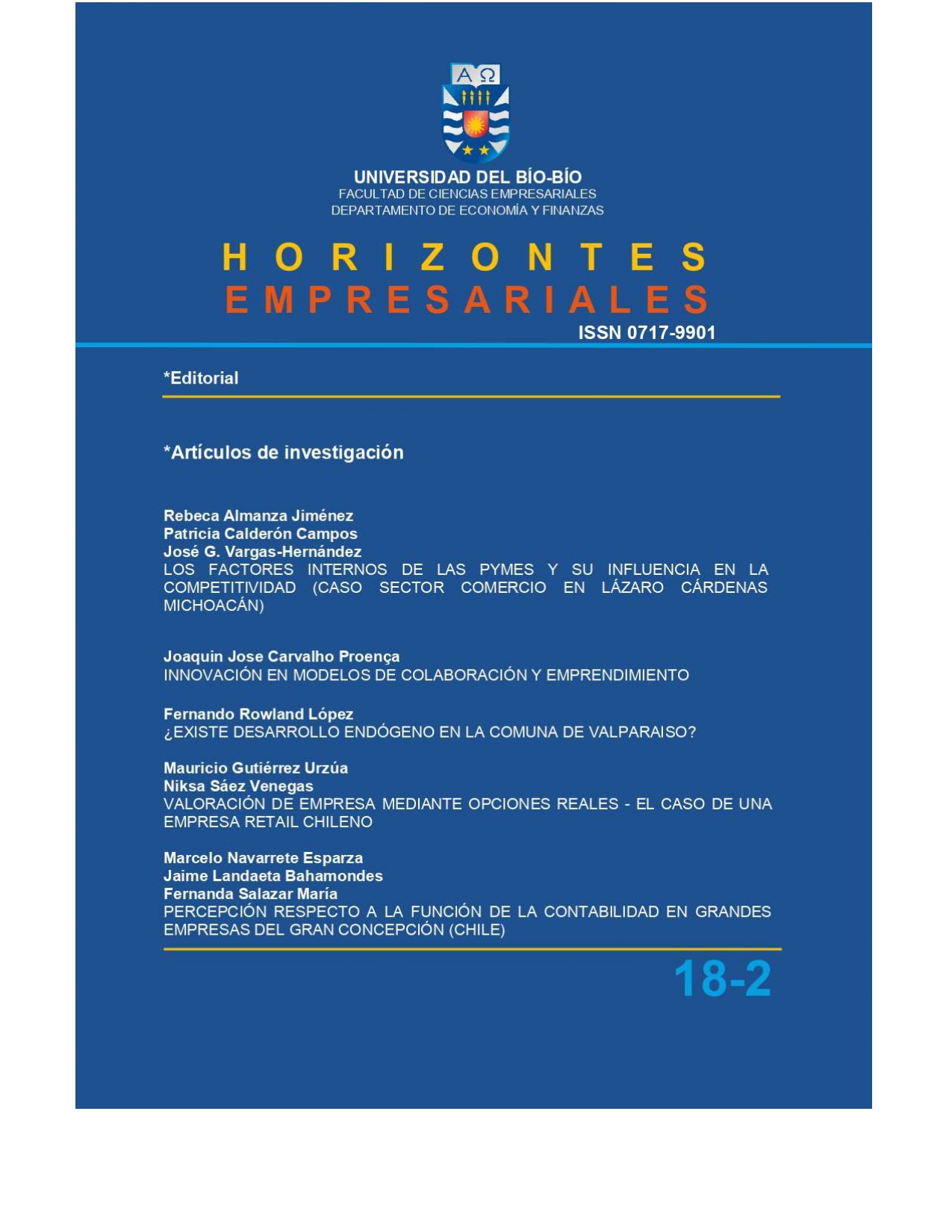Innovación en modelos de colaboración y emprendimiento
DOI:
https://doi.org/10.22320/hem.v18i2.3908Palabras clave:
Innovación abierta, Living Labs, Generación de valor, Modelos colaborativos, EmprendimientoResumen
Cómo generar valor a través de un modelo de innovación para destinos basado en enfoques de colaboración y emprendimiento. La innovación abierta, el diseño de servicios, los living labs, las TIC vinculadas a los nuevos desarrollos en tecnología y ciencia, la globalización directa o a través de redes y los productos y procesos de ecoinnovación son factores que se deben tener en cuenta al pensar en la innovación en los destinos. En la actualidad, la confluencia de economías abiertas, basadas en redes de colaboración con usuarios, proveedores, comunidades y actores institucionales; participación de los stakeholders para desarrollar nuevos servicios; calidad del medio ambiente a través de innovaciones que conllevan un beneficio ambiental; economía social, las organizaciones que persiguen objetivos no estrictamente comerciales proporcionan una colaboración entre el mercado y las fuerzas sociales, contribuyendo así a la innovación en los destinos.
Citas
of science and technology. London and New York: Routledge.
Boland, R., Collopy, F. (2004). Managing as designing. Stanford University Press, Stanford, California.
Brown, T. (2017). Change by Design, Revised and Updated: How Design Thinking Transforms Organizations and Inspires Innovation. New York, N.Y: Harper Collins Publishers.
Bush, V. (1945). Science, the endless frontier. U.S. Government Printing Office, Washington, D. C.
Chesbrough, H. (2003). Open innovation: The new imperative for creating and profiting from technology. Harvard Business School Press.
Chesbrough, H., Brunswicker, S. (2014). A Fad or a Phenomenon?: The adoption of open innovation practices in large firms. Research-Technology Management 57(2), 16-25.
Cohen, B. (2016). Making sense of the many business models in the sharing economy. June 4. Fast Company, Co.Exist.
Crane, A. Matten D. (2004). Business ethics: A European perspective, pp. 50–52. Oxford University Press.
Dahlander, L. Wallin, M. W. (2006). A man on the inside: Unlocking communities as complementary assets. Research Policy 35(8), 1243–1259.
Dodgson, M., Gann, D., & Salter, A. (2006). The role of technology in the shift towards open innovation: The case of Procter & Gamble. R&D Management 36(3), 333–346.
Droge, C., Stanko, M. A., & Pollitte W. A. (2010). Lead users and early adopters on the web: The role of new technology product blogs. Journal of Product Innovation Management 27(1), 66–82.
Ebner, W., Leimeister J. M., & Krcmar, H. (2009). Community engineering for innovations: The ideas competition as a method to nurture a virtual community for innovations. R&D Management 39(4), 342–356.
Felson, M., Spaeth, J.L. (1978). Community Structure and Collaborative Consumption: A routine activity approach. American Behavioral Scientist, 21(March–April), 614–624.
Freeman, E. (1984). Strategic management: A stakeholder approach. New York.: Cambridge University Press.
Freeman, E. (2003). Lecture – Stakeholder management revisited: What’s the state of the art? Leuven, 20 November.
Füller, J., Matzler, K., & Hoppe, M. (2008). Brand community members as a source of innovation. Journal of Product Innovation Management 25(6), 608-619.
Godin, B., Lucier, P. (2012). Innovation and conceptual innovation in ancient Greece (Working Paper No. 12). Project on the Intellectual History of Innovation, Montréal.
Howe, J. (2006). The rise of crowdsourcing. Wired June issue.
International Monetary Fund (1997). World economic outlook.
Jeppesen, L. B., Lakhani, K. R. (2010). Marginality and problem solving effectiveness in broadcast search. Organization Science 21(5), 1016–1033.
Lanning, M. J., Michaels, E. G. (1988). A Business is a value delivery system. McKinsey staff paper at Atlanta office.
Lara, P. V., Peréz, J. P. (2011). El empresario innovador y su relación con el desarrollo económico. TEC Empresarial, 5(3), 21-27.
Lundvall, B.A. (1985). Product innovation and user-producer interaction. Industrial Development Research. Series 31, Aalborg University Press.
Lundvall, B. A. (Ed.). (1992). National systems of innovation: Towards a theory of innovation and interactive learning. London, Pinter Publishing.
Mulgan, G., Tucker, S., Ali, R., & Sanders, B. (2007). Social Innovation: What it is, why it matters and how it can be accelerated. Oxford Saïd Business School, Skoll Centre for Entrepreneurship.
MSL Group (2013). Now and Next: Future of Engagement Report, pp 24/25. Retrieved from <a href="https://issuu.com/mslgroupofficial/docs/now-next-futureengagement" target="_blank">https://issuu.com/mslgroupofficial/docs/now-next-futureengagement</a>.
Oslo Manual (2005). <a href="https://www.oecd.org/sti/inno/2367580.pdf" target="_blank">https://www.oecd.org/sti/inno/2367580.pdf</a>
Phills Jr, J. A., Deiglmeier, K., & Miller, D. T. (2008). Rediscovering Social Innovation. Stanford Social Innovation Review, Fall 2008.
Pfitzer, M. Bockstette, V., & Stamp, M., (2013). Harvard Business Review, September issue.
Polino C., Castelfranchi, Y. (2012). ’The communicative turn’ in contemporary technoscience: Latin American approaches and global tendencies, IN Schiele B., Claessens, M., & Shi, S. (Eds.). Science communication in the world: Practices, theories and trends. New York, London: Springer Dordrecht Heidelberg.
Prahalad, C.K., Ramaswamy, V. (2000). Co-opting Customer Competence. Harvard Business Review, January-February 2000 issue.
Rothwell, R., Zegveld, W. (1985). Reindustrialization and technology. Armonk, New York: M.E. Sharpe.
Kline, S. J., Rosenberg, N. (1986). An overview of innovation, IN R. Landau, N. Rosenberg, (Eds.), The positive sum strategy: Harnessing technology for economic growth, pp. 275–305. Washington, D.C.:National Academy Press.
Kohler, T., Matzler, K., & Füller, J. (2009). Avatar-based innovation: Using virtual worlds for real-world innovation. Technovation 29(6–7), 395–407.
Schumpeter A. J. (1939). Business cycles, a theoretical, historical and statistical analysis of the capitalist process. New York: McGraw-Hill.
SIX. Retrieved from <a href="https://socialinnovationexchange.org" target="_blank">https://socialinnovationexchange.org</a>
Slaughter, S. (1993). Innovation and learning during implementation: a comparison of user and manufacturer innovation. Research Policy, 22(1), 81-97.
Skinner, Q. (2002). Visions of politics, volume I: Regarding method. Cambridge, U.K.: University Press.
Vanhaverbeke, W. (2014). Pushing the Boundaries – Part 2: Making open innovation relevant to more economic players, Innovation Management, May. Retrieved from <a href="http://www.innovationmanagement.se/2014/05/06/pushing-the-boundaries-part-2-making-open-innovation-relevant-to-more-economic-players/" target="_blank">http://www.innovationmanagement.se/2014/05/06/pushing-the-boundaries-part-2-making-open-innovation-relevant-to-more-economic-players/</a>.
Vargo S., Lusch, R. (2004). Evolving to a new dominant logic for marketing. Journal of Marketing 68(1), 1-17.
Vargo S. L. (2011). Market systems, stakeholders and value propositions. Toward a service-dominant logic-based theory of the market, IN Extending service-dominant logic. European Journal of Marketing, 45(1/2), 217-222.
Veugelers, M., Bury, J., & Viaene, S. (2010). Linking technology intelligence to open innovation. Technological Forecasting and Social Change 77(2), 335–343.
Visnjic, K, Van Looy, B. & Neely, A. (2013). Steering manufacturing firms towards service business model innovation. California Management Review 56(1), 100-123.
von Hippel, E. (1988). The Sources of Innovation. Oxford: Oxford University Press.
von Hippel, E. (2016). Free innovation. Cambridge, MA: MIT Press.
Waxenberger, B. L. Spence, (2003). Reinterpretation of a metaphor: From stakes to claims. Strategic Change 12, 239–249.
West, J., Bogers, M. (2014). Leveraging external sources of innovation: A review of research on open innovation. Journal of Product Innovation Management 31(4), 814–831.




